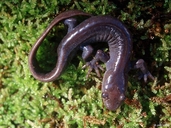|
Ambystoma jeffersonianum (Green, 1827)
Jefferson Salamander Subgenus: Xiphonura | family: Ambystomatidae genus: Ambystoma |
| Species Description: Green, J. (1827). An account of some new species of salamanders. Contributions of the Maclurian Lyceum to the Arts and Sciences 1 , 3–8. | |
 © 2000 John White (1 of 55) |
|
|
|
Description Distribution and Habitat Country distribution from AmphibiaWeb's database: Canada, United States U.S. state distribution from AmphibiaWeb's database: Connecticut, Illinois, Indiana, Kentucky, Massachusetts, Maryland, New Hampshire, New Jersey, New York, Ohio, Pennsylvania, Virginia, Vermont, West Virginia Canadian province distribution from AmphibiaWeb's database: Ontario
Life History, Abundance, Activity, and Special Behaviors Comments The species epithet, "jeffersonianum," is a reference to Jefferson College (Tighe 2023). Both Amblystoma platineum and Salamandra granulata have been synonymized with A. jeffersonianum (Tighe 2023).
References
Behler, J.L. and King, F.W. (1996). National Audubon Society Field Guide to North American Reptiles and Amphibians. Knopf, New York, NY. Bogart, JP, Bartoszek, J, Noble, DWA, Bi, K (2009). "Sex in unisexual salamanders: discovery of a new sperm donor with ancient affinities." Heredity, 103, 483-493. [link] Tighe, K.A. (2023). Catalog of type specimens of recent Caudata and Gymnophiona in the National Museum of Natural History, Smithsonian Institution. Smithsonian Contributions to Zoology 654. Originally submitted by: Kevin Gin (first posted 2003-11-25) Description by: Nessa Kmetec (updated 2022-10-05)
Distribution by: Nessa Kmetec (updated 2022-10-05)
Life history by: Nessa Kmetec (updated 2022-10-05)
Comments by: Nessa Kmetec (updated 2022-10-05)
Edited by: Vance T. Vredenburg (2023-08-11) Species Account Citation: AmphibiaWeb 2023 Ambystoma jeffersonianum: Jefferson Salamander <https://amphibiaweb.org/species/3835> University of California, Berkeley, CA, USA. Accessed May 23, 2025.
Feedback or comments about this page.
Citation: AmphibiaWeb. 2025. <https://amphibiaweb.org> University of California, Berkeley, CA, USA. Accessed 23 May 2025. AmphibiaWeb's policy on data use. |




 Raffaëlli Account
Raffaëlli Account Map of Life
Map of Life